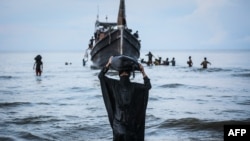ອົງການສະຫະປະຊາຊາດ ກະປະມານວ່າ ມີຊາວມຸລິມໂຣຮິງຢາຫຼາຍກວ່ານຶ່ງລ້ານຄົນ ໄດ້ພາກັນຫຼົບໜີອອກໄປຈາກມຽນມາ ເປັນຄື້ນຢ່າງຕໍ່ເນື່ອງ ແລະໃນຂະນະທີ່ສ່ວນໃຫຍ່ ໄດ້ພາກັນລົງຫຼັກປັກຖານ ໃນປະເທດເພື່ອນບ້ານ
ຂອງບັງກລາແດັສ, ແຕ່ມີຈຳນວນນຶ່ງໄດ້ນັ່ງເຮືອໄປຍັງອິນໂດເນເຊຍ ໃນຂະນະທີ່ເຈົ້າໜ້າທີ່ກຳລັງພິຈາລະນາ ການນໍາໃຊ້ເກາະສໍາລັບຊາວອົບພະຍົບໃນອະດີດນັ້ນ ມາເປັນບ່ອນຕັ້ງຖິ່ນຖານໃໝ່ ສໍາລັບພວກເຂົາເຈົ້າ. ອະຮາດຽນ ອຸຕະມາ (Ahadian Utama) ນັກຂ່າວ VOA ມີລາຍງານກ່ຽວກັບເລື້ອງນີ້, ເຊິ່ງ ທິບສຸດາ ຈະນຳເອົາລາຍລະອຽດ ມາສະເໜີທ່ານ.
ໃນມື້ນີ້, ຢູ່ເທິງເກາະກາລາງ (Galang) ມັນເປັນມື້ທີ່ງຽບສະຫງົບຫຼາຍ, ເກາະຂະຫນາດນ້ອຍທີ່ມີໄລຍະຫ່າງປະມານ 40 ກິໂລແມັດຈາກເກາະໃຫຍ່ ບາທາມ (Batam) ໃນຫມູ່ເກາະຣີອາວ (Riau) ຂອງອິນໂດເນເຊຍ, ແລະມີໄລຍະພຽງປະມານ 84 ກິໂລແມັດ ຈາກປະເທດເພື່ອນບ້ານສິງກະໂປ.
ບ່ອນພັກພິງເຫຼົ່ານີ້ ແມ່ນສິ່ງດຽວທີ່ເຄີຍໃຊ້ເປັນບ່ອນຢູ່ອາໄສຂອງອົບພະຍົບຊາວຫວຽດນາມ ທີ່ຍັງຫຼົງເຫຼືອຢູ່.
ທ້າວອາບູນາວາສ ຕານາໂວໂລ (Abunawas Tanawolo), ຜູ້ຢູ່ອາໄສໃນເກາະກາລາງ ກ່າວເປັນພາສາອິນໂດເນເຊຍວ່າ:
“ເຄີຍມີບ່ອນພັກພິງຫຼາຍພັນຫຼັງຢູ່ທີ່ນີ້, ແຕ່ປັດຈຸບັນ ຍັງເຫຼືອຢູ່ພຽງແຫ່ງດຽວ. ສ່ວນຫຼັງອື່ນໆແມ່ນຖືກທໍາລາຍໝົດແລ້ວ ເນື່ອງຈາກພວກມັນເຮັດດ້ວຍໄມ້.”
ທ້າວອາບູນາວາສ ຕານາໂວໂລ, ອາຍຸ 50 ປີ, ເປັນພະນັກງານຮັກສາຄວາມປອດໄພຢູ່ໃນສູນອົບພະຍົບໃນເມື່ອກ່ອນ ແລະເປັນຜູ້ທີ່ໄດ້ອາໄສຢູ່ເທິງເກາະດັ່ງກ່າວນີ້ຕັ້ງແຕ່ສະໄໝທີ່ລາວຍັງເປັນເດັກນ້ອຍ. ລາວຍັງຈື່ຈຳທີ່ລາວໄດ້ຫຼິ້ນ ກັບເດັກນ້ອຍຊາວຫວຽດນາມຈາກສູນດັ່ງກ່າວ ແລະໄດ້ໃກ້ຊິດກັບຄອບຄົວອົບພະຍົບຊາວຫວຽດນາມຄອບຄົວນຶ່ງ.
ແຕ່ປີ 1979 ຫາປີ 1996, ເກາະແຫ່ງນີ້ ເປັນບ່ອນຢູ່ອາໄສຂອງອົບພະຍົບຊາວຫວຽດນາມ ທີ່ຫຼົບໜີຄວາມຂັດແຍ້ງໃນບ້ານເກີດຂອງພວກເຂົາເຈົ້າ, ສ່ວນຫຼາຍແມ່ນໜີມາທາງເຮືອ, ພ້ອມດ້ວຍຊາວກຳປູເຈຍ ແລະຊາວລາວຈຳນວນນຶ່ງທີ່ໄດ້ໜີມາເຊັ່ນດຽວກັນ. ໂດຍການຄາດຄະເນຂອງບາງຄົນກ່າວວ່າ ມີຜູ້ອົບພະ ຍົບປະມານ 250 ພັນຄົນເຄີຍຮ້ອງເກາະແຫ່ງນີ້ວ່າ ເປັນບ້ານພັກຊົ່ວຄາວຂອງ ພວກເຂົາເຈົ້າ.
ປັດຈຸບັນ, ສິ່ງທີ່ຍັງເຫຼືອຢູ່ແມ່ນບ່ອນພັກພິງທີ່ຫວ່າງເປົ່າ ແລະເປື່ອຍພັງລົງມາ, ເຊັ່ນດຽວກັບອະດີດໂຮງໝໍກາແດງຂອງອິນໂດເນເຊຍ, ໂບດກາໂຕລິກເກົ່າຂອງຊາວຫວຽດນາມ, ແລະສຸສານສຳລັບອົບພະຍົບຊາວຫວຽດນາມທີ່ເສຍຊີວິດກ່ອນຈະໄດ້ຮັບການຍົກຍ້າຍຖິ່ນຖານ. ປັດຈຸບັນນີ້, ສະຖານທີ່ດັ່ງກ່າວໄດ້ກາຍມາເປັນອານຸສອນສະຖານ ແລະເປັນສະຖານທີ່ທີ່ດຶງດູດເອົານັກທ່ອງທ່ຽວ. ແຕ່ ເກາະດັ່ງກ່າວກໍພົບວ່າ ມັນກໍາລັງເປັນຈຸດສຸມຂອງການອະພິປາຍກ່ຽວກັບຄື້ນຂອງຊາວອົບພະຍົບຄັ້ງໃໝ່.
ໃນຂະນະນີ້, ເຈົ້າໜ້າທີ່ຂອງອິນໂດເນເຊຍ ກໍາລັງພິຈາລະນາໃຫ້ເກາະກາລາງ ກາຍມາເປັນບ່ອນພັກເຊົາ ຂອງຜູ້ອົບພະຍົບຊາວໂຣຮິງຢາ ທີ່ກໍາລັງອອກຈາກ ມຽນມາໂດຍເຮືອ, ແລະກໍາລັງມາຮອດແຂວງອາເຈ (Aceh) ທີ່ຕັ້ງຢູ່ໃນສ່ວນຕາເວັນຕົກສຸດ ຂອງໝູ່ເກາະອິນໂດເນເຊຍ. ຢູ່ໃນແຂວງອາເຈ, ການມາເຖິງຂອງເຂົາເຈົ້າ ໄດ້ຖືກຕ້ອນຮັບແບບບໍ່ພໍໃຈຢ່າງແຮງ.
ເຈົ້າໜ້າທີ່ລັດຖະບານໃນເມືອງ ບາທາມ ທີ່ຄຸ້ມຄອງເກາະກາລາງ ໄດ້ພາກັນປຶກສາຫາລືກ່ຽວກັບຄວາມເປັນໄປໄດ້ ໃນການຕັ້ງຖິ່ນຖານໃໝ່.
ທ່ານຣູດີ ປັນໃຈທານ (Rudi Panjaitan), ໂຄສົກຂອງເມືອງບາທາມ ກ່າວເປັນພາສາອິນໂດເນເຊຍວ່າ:
“ກ່ຽວກັບເລື່ອງນີ້, ລັດຖະບານເມືອງບາທາມ ຈະປະຕິບັດຕາມຄຳສັ່ງຕ່າງໆທີ່ມາຈາກລັດຖະບານກາງໂດຍກົງ, ເພາະວ່າອຳນາດການຄຸ້ມຄອງຊາວອົບພະຍົບຈາກຕ່າງປະເທດ ແມ່ນຂຶ້ນຢູ່ກັບລັດຖະບານກາງ.”
ຊາວເກາະກາລາງບາງຄົນ ມີຄວາມກັງວົນກ່ຽວກັບຂໍ້ສະເໜີການຕັ້ງຖິ່ນຖານໃໝ່ນັ້ນ.
ນາງເດວີ ເພີວານຕີ (Dewi Purwanti), ປະຊາຊົນທີ່ອາໄສໃນເກາະກາລາງ ກ່າວເປັນພາສາອິນໂດເນເຊຍວ່າ:
“ໃນຖານະທີ່ເປັນຄົນທ້ອງຖິ່ນ, ມີການຄັດຄ້ານຕໍ່ຜູ້ອົບພະຍົບຊາວໂຣຮິງຢາຢູ່ທີ່ນີ້ ເນື່ອງຈາກມັນຈະມີຜົນສະທ້ອນຕໍ່ພວກເຮົາ. ເພາະວ່າ ແມ່ນແຕ່ປະຊາຊົນໃນແຂວງອາເຈເອງ ກໍບໍ່ແມ່ນເລື້ອງງ່າຍໃນການປາກົດໂຕຂອງຜູ້ອົບພະຍົບຊາວໂຣຮິງຢາຢູ່ທີ່ນັ້ນ.”
ສ່ວນຄົນອື່ນໆສັງເກດວ່າ ນັບຕັ້ງແຕ່ທ້າຍຊຸມປີ 1990, ເກາະກາລາງ ແລະບັນດາເກາະອື່ນໆທີ່ຢູ່ອ້ອມແອ້ມເກາະໃຫຍ່ບາທາມ ແມ່ນໄດ້ຮັບການເຊື່ອມຕໍ່ໂດຍຂົວຫຼາຍແຫ່ງ.
ທ້າວອາບູນາວາສ ຕານາໂວໂລ, ອະດີດພະນັກງານຮັກສາຄວາມປອດໄພຢູ່ທີ່ສູນອົບພະຍົບໃນເມື່ອກ່ອນ ກ່າວເປັນພາສາອິນໂດເນເຊຍ ວ່າ:
"ບັດນີ້ ຖ້າເກາະຫາກຖືກໃຊ້ເປັນບ່ອນພັກເຊົາ ຂອງຜູ້ອົບພະຍົບຊາວໂຣຮິງຢາ, ມັນຈະເປັນການຍາກສໍາລັບເຈົ້າໜ້າທີ່ ທີ່ຈະຮັກສາ ແລະປົກປ້ອງພວກເຂົາເຈົ້າຢູ່ເທິງເກາະແຫ່ງນີ້."
ອີງຕາມຂໍ້ມູນຂອງຂ້າຫຼວງໃຫຍ່ດ້ານອົບພະຍົບຂອງອົງການສະຫະປະຊາຊາດພົບວ່າ ຈຳນວນຜູ້ອົບພະຍົບຊາວໂຣຮິງຢາ ທີ່ເຂົ້າໄປໃນອິນໂດເນເຊຍຜ່ານແຂວງອາເຈນັບແຕ່ເດືອນພະຈິກເປັນຕົ້ນມາ ມີຫຼາຍກວ່າ 1,500 ຄົນແລ້ວ.
The U.N. estimates more than a million Rohingya Muslims have fled Myanmar in successive waves. And while most ended up in neighboring Bangladesh, some have taken boats to Indonesia where authorities are now considering using a former refugee island for their resettlement. VOA's Ahadian Utama has more.
It’s very quiet these days, on Galang Island, a small island some 40 kilometers from the main island of Batam in Indonesia's Riau Islands, and only around 84 kilometers from neighboring Singapore.
These barracks are the only remaining structure that used to house Vietnamese refugees.
Abunawas Tanawolo, Galang Islander, male in Indonesian.
“There used to be thousands of barracks here, but now only one remains. The others are now destroyed, because they are made of wood…”
50-year-old Abunawas Tanawolo was a security guard at the former refugee camp and has lived on the island since childhood. He remembers playing with Vietnamese children from the camp and was very close to one family of Vietnamese refugees.
From 1979 to 1996, this island was home to Vietnamese refugees fleeing conflict in their homeland, mostly by boat, along with some Cambodians and Laotians doing the same. By some estimates, some 250 thousand refugees once called this island their temporary home.
What remains now are crumbling empty buildings, like this former Indonesian Red Cross Hospital, an old Vietnamese Catholic Church, and a cemetery for Vietnamese refugees who died before being able to be resettled. The site is now a memorial and tourist attraction. But the island itself is now finding itself at the center of a debate about a new wave of refugees.
Indonesian authorities are now considering Galang Island to house Muslim Rohingya refugees, fleeing Myanmar by boat, and arriving in nearby Aceh Province, in the westernmost part of the Indonesian archipelago. In Aceh, their arrival has received a fierce backlash.
Officials at the Batam City government that administers Galang Island have discussed the possible resettlement.
Rudi Panjaitan, Batam City Spokesman, Male in Indonesian.
“Regarding this matter, the Batam City Government will defer to what is the directive of the central government, because the authority to handle refugees from abroad is with the central government.”
Some Galang islanders are concerned about the resettlement proposal.
Dewi Purwanti, Galang Islander, Female in Indonesian.
“We as locals, object to Rohingya refugees being placed here, because there will be consequences for us. Because even people in Aceh are uneasy with the presence of Rohingya refugees there.”
Others note that since the late 1990s, Galang, and other islands surrounding Batam are interconnected by bridges.
Abunawas Tanawolo, Galang Ex-Refugee Camp Staff, Male in Indonesian.
“Now if it’s to be used as a shelter for Rohingya refugees, it would be hard for the authorities to keep and guard them on the island.”
According to data from the United Nations High Commissioner for Refugees, the number of Rohingya refugees who entered Indonesia via Aceh since November reached more than 1,500 people.






ຟໍຣັມສະແດງຄວາມຄິດເຫັນ